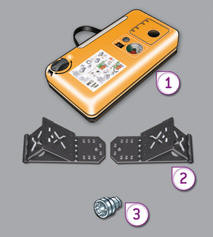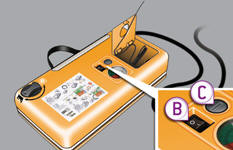Temporary puncture repair kit
Complete system consisting of a compressor and a sealant cartridge which permits temporary repair of a tyre so that you can drive to the nearest garage.
It is designed to repair most punctures which could affect the tyre, located on the tyre tread or shoulder.
Access to the kit

The kit is stowed in the boot under the floor. It is installed in the tool box, located under the storage box.
List of tools

All of these tools are specific to your vehicle. Do not use them for other purposes.
1. 12 V compressor.
Contains a sealant cartridge for the temporary repair of a tyre and can be used to adjust the tyre pressures.
2. Two chocks to chock the vehicle.
3. Socket for security bolts (located in the glove box) * .
For adapting the wheelbrace to the special security bolts.
Other accessories

4. Removable towing eye.
5. Electric parking brake emergency release control.
Description of the kit

A. "Sealant" or "Air" position selector.
B. On "I" / off "O" switch.
C. Defl ation button.
D. Pressure gauge (in bar or p.s.i.).
E. Compartment housing:
- a cable with adaptor for 12 V socket,
- various infl ation adaptors for accessories, such as balls, bicycle tyres...

F. Sealant cartridge.
G. White pipe with cap for repair.
H. Black pipe for infl ation.
I. Speed limit sticker.
![]() The speed limit sticker I must be affixed to the vehicle's steering wheel
to remind you that a wheel is in temporary use.
The speed limit sticker I must be affixed to the vehicle's steering wheel
to remind you that a wheel is in temporary use.
Do not exceed a speed of 50 mph (80 km/h) when driving with a tyre repaired using
this type of kit.
Repair procedure
1. Sealing

Switch off the ignition.
Turn the selector A to the "sealant" position.

Check that the switch B is in position "O" .
![]() Avoid removing any foreign bodies which have penetrated into the tyre.
Avoid removing any foreign bodies which have penetrated into the tyre.

Uncoil the white pipe G fully.
Unscrew the cap from the white pipe.
Connect the white pipe to the valve of the tyre to be repaired.
![]() Take care, this product is harmful (e.g. ethylene-glycol, colophony...)
if swallowed and causes irritation to the eyes.
Take care, this product is harmful (e.g. ethylene-glycol, colophony...)
if swallowed and causes irritation to the eyes.
Keep this product out of the reach of children.

Connect the compressor's electric plug to the vehicle's 12 V socket.
Start the vehicle and leave the engine running.
![]() Do not start the compressor before connecting the white pipe to the tyre
valve: the sealant product would be expelled through the pipe.
Do not start the compressor before connecting the white pipe to the tyre
valve: the sealant product would be expelled through the pipe.

Switch on the compressor by moving the switch B to position "I" until the tyre pressure reaches 2.0 bars.
The sealant is injected into the tyre under pressure; do not disconnect the pipe from the valve during this operation (risk of splashing).
![]() If after around 5 to 7 minutes the pressure is not attained, this indicates
that the tyre is not repairable; contact a PEUGEOT dealer or a qualified workshop
for assistance.
If after around 5 to 7 minutes the pressure is not attained, this indicates
that the tyre is not repairable; contact a PEUGEOT dealer or a qualified workshop
for assistance.

Remove the kit and screw the cap back on the white pipe.
Take care to avoid staining your vehicle with traces of fl uid. Keep the kit to hand.
Drive immediately for approximately three miles (fi ve kilometres), at reduced speed (between 15 and 35 mph (20 and 60 km/h)), to plug the puncture.
Stop to check the repair and the tyre pressure using the kit.
![]() Tyre under-infl ation detection
Tyre under-infl ation detection
If the vehicle is fitted with tyre under-infl ation detection, the under-infl ation warning lamp will remain on after the wheel has been repaired until the system is reinitialised by a PEUGEOT dealer or a qualified workshop.
2. Infl ation

Turn the selector A to the "air" position.

Uncoil the black pipe H fully.
Connect the black pipe to the valve of the wheel.

Connect the compressor's electric plug to the vehicle's 12 V socket.
Start the vehicle again and leave the engine running.
![]() As soon as possible, go to a PEUGEOT dealer or a qualified workshop.
As soon as possible, go to a PEUGEOT dealer or a qualified workshop.
You must inform the technician that you have used this kit. After inspection, the
technician will advise you on whether the tyre can be repaired or if it must be
replaced.

Adjust the pressure using the compressor (to inflate: switch B in position "I" ; to defl ate: switch B in position "O" and press button C ), in accordance with the vehicle's tyre pressure label (located on the left hand door aperture).
A loss of pressure indicates that the puncture has not been fully plugged; contact a PEUGEOT dealer or qualified workshop for assistance.
Remove and stow the kit.
Drive at reduced speed (50 mph [80 km/h] max) limiting the distance travelled to approximately 120 miles (200 km).
Removing the cartridge

Stow the black pipe.
Detach the angled base from the white pipe.
Support the compressor vertically.
Unscrew the cartridge from the bottom.
![]() Beware of discharges of fl uid.
Beware of discharges of fl uid.
The expiry date of the fl uid is indicated on the cartridge.
The sealant cartridge is designed for single use; even if only partly used, it must
be replaced.
After use, do not discard the cartridge into the environment, take it to an authorised
waste disposal site or a PEUGEOT dealer.
Do not forget to obtain a new sealant cartridge, available from PEUGEOT dealers
or from a qualified workshop.
Checking tyre pressures / inflating accessories
You can also use the compressor, without injecting any product, to:
- check or adjust the pressure of your tyres,
- inflate other accessories (balls, bicycle tyres...).

Turn the selector A to the "Air" position.

Uncoil the black pipe H fully.
Connect the black pipe to the valve of the wheel or accessory.
If necessary, fi t one of the adaptors supplied with the kit first.

Connect the compressor's electrical connector to the vehicle's 12 V socket.
Start the vehicle and let the engine run.
Adjust the pressure using the compressor (to inflate: switch B in position "I" ; to defl ate: switch B in position "O" and press button C ), according to the vehicle's tyre pressure label or the accessory's pressure label.
Remove the kit then stow it.
With the JBL bass unit

To make the operation easier, remove the adjustable boot floor, unscrew the yellow central bolt,

remove the bass unit disconnecting the electrical harness, remove the polystyrene storage box.
See also:
Locations for ISOFIX child seats (308 SW with individual rear seats)
In accordance with European Regulations, this table indicates the options for
installing ISOFIX child seats on seats in the vehicle fitted with ISOFIX mountings.
In the case of universal and semi ...
Advice on child seats
in a vehicle compromises the child's protection in the event of an accident.
Remember to fasten the seat belts or the child seat harnesses keeping the slack
relative to the child's body to ...
Stopping the vehicle
Before switching off the engine, you can choose to:
- move to position N to engage neutral,
- leave the gear engaged; in this case, it will not be possible to move the vehicle.
In both cases, you m ...






